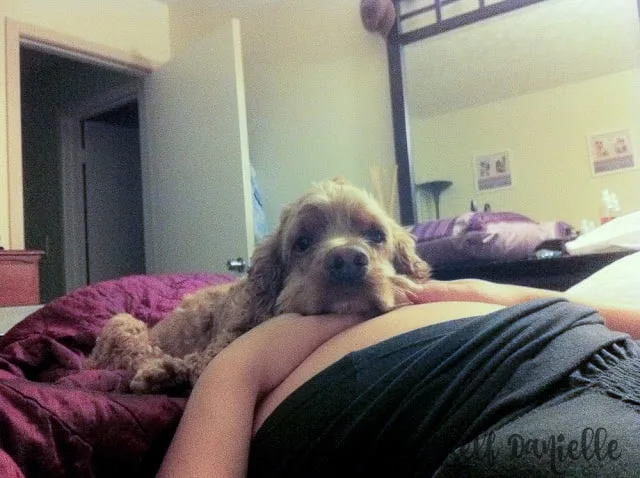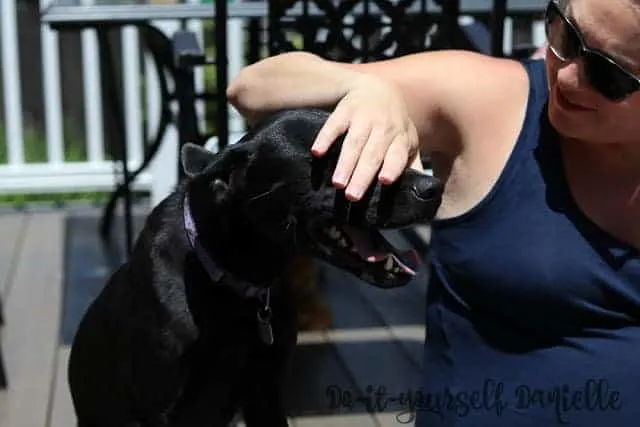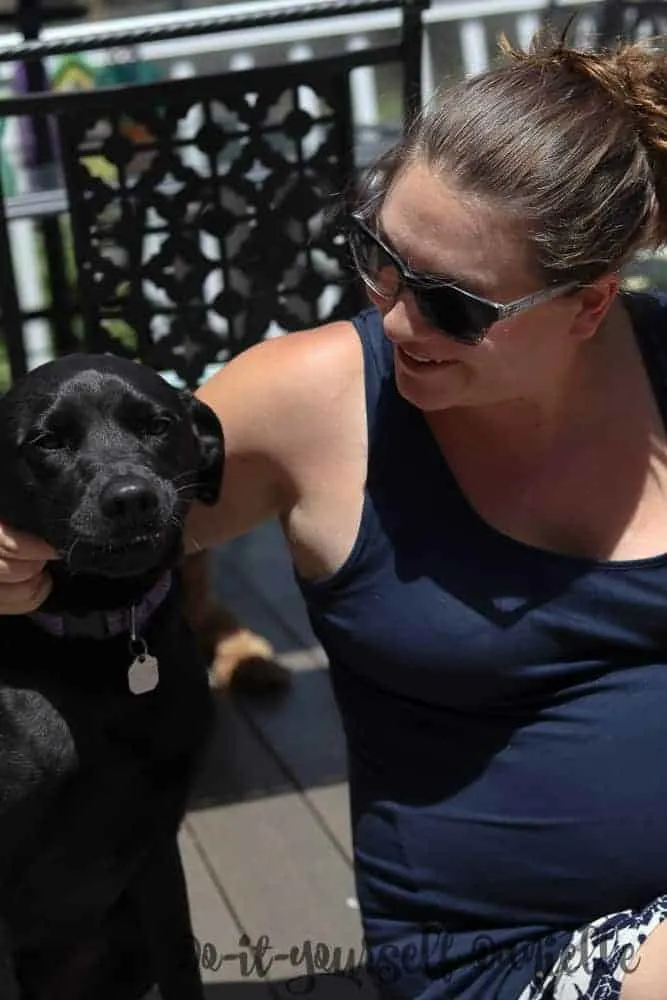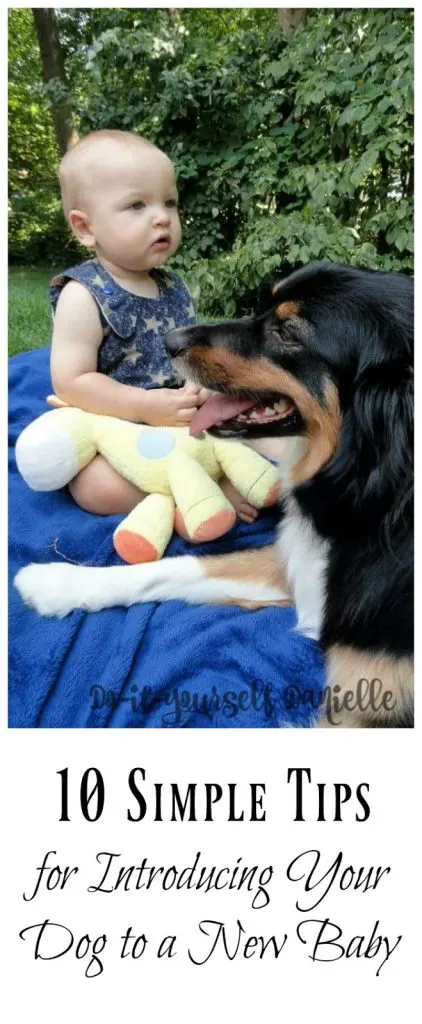 |
| Training Rocky to deal with different types of touch- in this case, touching his paws. |
How to prepare your dog for a new baby. Tips and tricks that may make the family transition easier when you bring a baby home from the hospital. #ZylkeneDifference #MyHappyPets #ad
This is a product-provided, sponsored conversation that contains affiliate links. I received Zylkene products for my own personal use. All opinions, text and experiences are my own. Please consult your veterinarian before giving your pet Zylkene. Follow the recommended administration on the package, unless otherwise instructed by your veterinarian. If your pet’s behavior changes suddenly in any way, schedule an appointment with your veterinarian. He or she can rule out any underlying medical issues as well as make additional recommendations. Danielle at DIYDanielle.com is not a veterinarian or behavior specialist for pets. This post is written from her personal experiences with her dogs and research she has done on the topic. Please consult with a professional if you have any questions or concerns about preparing your dog for baby. Each dog has unique training needs.
Our third son is due in August and yet again, we’re helping two dogs adjust to our changing family dynamic. And it’s a big change. Babies make a lot of noise, they take up a lot of attention, and they’re fragile. Depending on your dog, they could love having a baby around or hate it.
For the births of my two older sons, we had two dogs, Tyson and Willow. Willow had a loving, motherly personality and absolutely adored babies. She would sit next to me on the couch with her head on my arm as I nursed the baby and she was always enthusiastic about new additions. The most I needed to worry about with her is that she’d knock a toddler over as he was learning to walk. She was absolutely the best family dog ever, but sadly she passed away a couple weeks after my second son was born.
Tyson though. My gosh. This poor dog. I’m pretty sure we will break his heart bringing another baby home. He hasn’t coped well with any of our new additions to the family- including when I brought my husband home.
Not. Well.
 |
| Tyson’s favorite spot when I was pregnant with my first son. |
I was worried I was doing something wrong with him, but my other two dogs have both been great. Some dogs, like some humans, just seem to have a harder time coping with change.
Needless to say, I know we’ll need to prepare him- as much as possible- for this baby.
As for our other dog, Rocky, he’s a rescue dog. He’s been pretty good about our 3 and 5 year old so I imagine he will be fine, but it never hurts to be prepared. But at the very least, he doesn’t get terribly upset when the kids cry or scream or run around like maniacs.
Tyson howls when the kids cry. If you know any 3 year olds, they cry over everything (i.e. “my brother looked at me the wrong way”) so he howls a lot. Hopefully this baby is a happy baby and not colicky like my first.
Tips for Preparing Your Dogs for a Baby
1. Consider any changes you need to make- and make them early.
I think it’s easy to foster resentment in a dog if you make unpleasant changes immediately upon bringing a new baby home. It’s also harder to make changes when you’re up all night caring for a baby.
Start early. If you can, start before you even get pregnant.
This includes changes like what rooms they’ll be allowed in, how often they’ll be in a crate, if you’re going to implement any new training methods, etc. Changing furniture around. All your nesting… get it done.
We made a couple of changes recently to prepare for baby, but the big change was that we stopped allowing our dogs to sleep on the couch. I went out and bought them their own beds. They now have designated spots just for them and those spots are close to where I like to sit on the couch. They are happy. They have a cue phrase (“on your bed”) for when I want them to go lay down. Offering a treat or verbal/physical praise when they comply is a great way to train your dog to spend more time in their bed.
 |
| Tyson on his dog bed. Transitioning the dogs off the couches was important to us so we set them up with their own beds. |
2. Prepare a quiet spot for your dog where he can feel safe.
We put our dogs in doggy “time out.” Tyson, in particular, would need a time out when the kids were younger. I would look for signs that he was feeling stressed, then I would relocate him to a quieter place if he needed a few kid-free minutes. Make sure to keep an eye out for signs of anxiety in your dog.
Take me with you Tyson! No man (or woman) left behind!
3. Work to desensitize your dog to typical baby/toddler behaviors.
This isn’t a perfect science, but I think it’s helpful to desensitize your dog to typical baby and toddler behaviors. Pulling their ears, tail, touching all over their body. Holding their paws. Kids have no boundaries! Welcome to parenthood! You may want to desensitize yourself while you’re at it.
Help your dog not have an anxious response to that type of touch. Practice some of these behaviors before the baby even gets here. Reward your dog for sitting nicely for that touch. We did a lot of this desensitization with our dogs as puppies because I trained them to be therapy dogs and it’s part of the training.
 |
| Brushing my hands over Rocky’s eyes, touching his mouth and nose can help prepare him for baby. |

The nice thing is that babies mature slowly. I like to joke that babies have a built in method for preparing dogs for their craziness. At first, they’re too small to be any trouble at all. They grow slowly, taking months to be even remotely close to mobile. By the time they’re really able to catch the dog, they’ve been dropping food from their high chairs for months. Tyson definitely hates new family members, but he does love food scraps from the kids. And three kids worth of food scraps is better than two. So by the time the kids were super annoying, the dogs usually were feeling pretty friendly towards them.
4. Plan to supervise your dog and any interaction with baby.
Please supervise your child and pets. Seriously. As much as I trusted Willow, I don’t leave my dogs alone with my kids until I know my kids can be trusted.
Kids are rough. They don’t think things through. And animals have a strong instinct to protect themselves. If you have other kids, you probably understand that they are not great planners. They wait until you aren’t looking, then jump on you. It’s not mean, it’s not intentional, but you learn to guard your sensitive areas.
And even as human adults, we can struggle to have an appropriate and calm reaction to getting injured by our children… even when it is an innocent mistake.
We can’t rely on our pets to react calmly. Heck, I don’t even rely on other humans to react calmly to certain things my kids do. That’s why I screen my care providers. It’s not fair to your pet to give them more credit than you do your daycare provider. They are not a dog from a Disney movie, just like we aren’t Mary Poppins!
5. Keep a reliable schedule.
For some things, make sure to keep a reliable schedule. Specifically, make sure you continue to feed, walk, water, and let your dogs out on a consistent schedule. Pick up extra dog food before the baby is born so you won’t run out if you’re having a rough recovery. You won’t be able to lift a bag of dog food for 6-8 weeks post-delivery.
Like people, animals like and feel safe when some things remain the same. Feeding schedules are big for animals. They rely on us to give them food or water… without that attention, they would die. Being able to provide that security means your dog is in a better space to deal with the anxiety of having a new family member.
6. Bring home something with baby’s scent before you bring the baby home.
If you have the opportunity, have someone bring home something of baby’s before you bring baby home. Let the dog sniff it.
7. Start teaching your children to respect animals early.
It needs to start now and you can keep working on teaching respect and boundaries with animals as your child gets older. A baby isn’t really going to understand, but even at 3 months old, we take our babies’ hands and show them how to pet the dog. We say, “Gentle!” in a calm voice and make it pleasant for the baby and dog. If the dog gets anxious, we stop. If the baby gets rough, we stop and try again later.
8. First impressions are important.
When you come home from the hospital with the baby, you can have someone leash your dog(s) and give them treats if they remain calm as you bring baby in.
Stay calm, don’t act nervous, and greet your dog as normal (as much as possible). Make it a positive experience. You could even bring home a present for the dog “from the baby.” I really like deer antlers for dogs that chew a lot.
I highly recommend training your dog not to jump on you. If you happen to have a c section (and even if you don’t), a dog jumping up on you post-partum is going to hurt. I learned this the hard way and it’s happened after both of my c sections- OUCH! And you don’t want the dog jumping on you when you have a baby in your arms either.
9. Use calming products if needed.
If you are concerned about your pet’s reaction to a new baby, it might be worth trying a calming product to help keep them relaxed. Zylkene is a behavior supplement that helps promote calm in your pet without sedating or making your pet drowsy. It can be mixed into your pet’s food once daily.

Zylkene is available at your veterinary clinic or online. Visit the Zylkene website for details or ask your veterinary clinic for it by name. You can also follow MyHappyPetsUSA on Facebook or Instagram.
10. Don’t forget the pet sitter!
Don’t forget to hire a pet sitter for when you’re at the hospital. We had a pet sitter on-call when our first son was due, but our in-laws watch the dogs and kids now.
In the end, you want to try to do as much of this as possible. But dogs are great pets usually. They’re pretty adaptive. You’ll make mistakes. You’ll forget something. Most likely, it will be just fine. I know there are some exceptions and some dogs struggle with different age children, but if you supervise your children and dogs carefully then you should be able to keep everyone safe.
What challenging situation do your pets have to cope with?
Love it? Pin it!

Zylkene is ideal for pets to help cope with various challenging situations, such as loud noises (fireworks, thunderstorms), traveling with pets, etc. Ask for Zylkene by name at your veterinary clinic, or purchase it online.
Click here to learn more about Zylkene non-drowsy calming supplements for your dog or cat.
This is a product-provided, sponsored conversation that contains affiliate links. I received Zylkene products for my own personal review. All opinions, text and experiences are my own.If your pet’s behavior changes suddenly in any way, schedule an appointment with your veterinarian. He or she can rule out any underlying medical issues as well as make additional recommendations. Consult your veterinarian before giving your pet Zylkene. Follow the recommended administration on the package, unless otherwise instructed by your veterinarian.
Comments submitted may be displayed on other websites owned by the sponsoring brand, Vetoquinol.
Thanks for taking the time to read this post! I really appreciate the time you’ve taken. Please share, like, and pin my post if you enjoyed it. Follow me on social media and subscribe to my email list to keep up to date on all of my latest projects!

